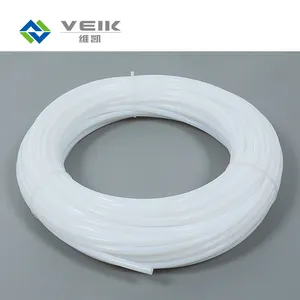
Durable And Reliable 12m Seamless Steel Pipes 6m Round Fluid Pipe With Welding Bending Cutting Punching Services API Certified





















The PTFE tube, a pivotal component in additive manufacturing, plays a crucial role in facilitating the seamless movement of filament from the extruder to the hot end. Understanding the properties, applications, and configurations of this extruded PTFE tube is essential for those engaged in 3D printing processes.
PTFE, or polytetrafluoroethylene, is a high-performance polymer known for its excellent thermal and chemical resistance. The 3D printer PTFE tube leverages these characteristics to ensure smooth filament flow and prevent heat-induced deformities during the printing process. This extruded PTFE tube serves as a reliable conduit, allowing precise control over filament placement and deposition. PTFE tubes are widely used in chemical processing industries for transporting corrosive chemicals. Their resistance to a broad range of chemicals makes them ideal for handling acids, bases, and other reactive substances without the risk of material degradation.
PTFE tube fittings and PTFE tube connectors are integral components that contribute to the seamless functioning of the 3D printer PTFE tube. These fittings are designed to securely join sections of the tube, maintaining a continuous and airtight pathway for the filament. The precision of PTFE tube connectors is crucial in preventing leaks and ensuring consistent material flow, thereby contributing to the overall efficiency of the 3D printing process.
Extruded PTFE tube refers to the manufacturing process by which the tube is produced. Extrusion involves forcing molten PTFE through a die, resulting in a continuous length of tubing with a uniform diameter. This process ensures the tube's consistency and construction, which are essential for its performance in 3D printing applications.
One may inquire, "What is a PTFE tube?" Simply put, a PTFE tube is a flexible conduit made from polytetrafluoroethylene, characterized by its non-stick surface, resistance to high temperatures, and chemical inertness. These properties make it an ideal choice for 3D printing, where precise control over material flow and resistance to heat are paramount.
The 3D printer PTFE tube's compatibility with various filaments, including PLA, ABS, and PETG, further enhances its versatility. The extruded PTFE tube accommodates different filament types without the risk of material adherence, contributing to the overall reliability and consistency of the 3D printing process. PTFE tube fittings and connectors come in diverse configurations to suit the specific requirements of 3D printers. Whether it's a straight connector, elbow fitting, or other variations, these components contribute to the adaptability of the PTFE tube in different printer setups. The precise engineering of these fittings ensures a secure and reliable connection, minimizing the likelihood of disruptions during the printing process.
In summary, the 3D printer PTFE tube, characterized by its extruded construction and compatibility with various filament types, stands as a vital component in additive manufacturing. The inclusion of PTFE tube fittings and connectors underscores its adaptability and reliability in diverse 3D printing setups. The inherent properties of PTFE, including its non-stick surface and resistance to high temperatures, make it an ideal material for facilitating the smooth and precise movement of filament during the printing process. As additive manufacturing continues to evolve, the role of the PTFE tube remains central in ensuring the efficiency and quality of 3D-printed objects.